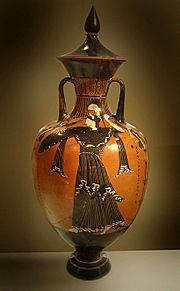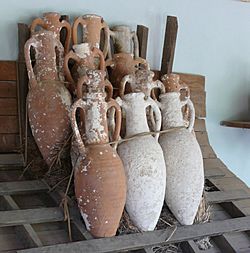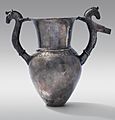Amphora facts for kids

In Ancient Greece and Ancient Rome, amphoras were used to transport liquids or grain. Amphores had two handles, used for carrying. Amphores existed in different sizes, between 5 litres and 50 litres. They were made of clay, or metal. Cargo ships for liquids were full of amphorae.
Most of the amphoras that now exist were made in old times of Ancient Greece and Ancient Rome. However, many were made long before then. Some Amphoras are as old as 4500 BCE. Some varieties have been found in ancient China.
Images for kids
-
Amphora found in Banpo (China), made by the Yangshao culture; 5000–3000 BC; Guimet Museum (Paris)
-
Large late Geometric Attic amphora; 725–700 BC; Louvre (Paris, France)
-
Panathenaic prize amphora for runners; circa 530 BC; terracotta; height: 62.2 cm (241⁄2 in.); Metropolitan Museum of Art (New York City)
-
Greek amphora; 2nd half of the 2nd century BC; glass; from Olbia (Roman-era Sardinia); Altes Museum (Berlin)
See also
 In Spanish: Ánfora para niños
In Spanish: Ánfora para niños








